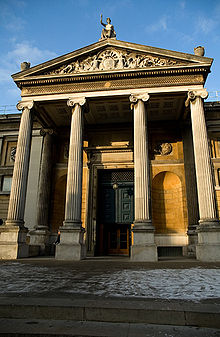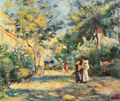- Ashmolean Museum
-
Das gegenwärtige Ashmolean Museum (Ashmolean Museum of Art and Archaeology) ist ein 1845 in Oxford als University Gallery erbautes Museum. Seit 1894 ist darin die Ashmolean-Sammlung untergebracht.
Inhaltsverzeichnis
Geschichte
In seinem früheren Gebäude öffnete die Sammlung am 24. Maijul./ 3. Juni 1683greg. die Türen für das Publikum.[1] Es war und ist das erste einer Universität angegliederte Museum auf der Welt. Bei dieser Kunst- und Antikensammlung handelte es sich ursprünglich um die Sammlung von Raritäten der beiden königlichen Gärtner namens John Tradescant (Vater und Sohn). Ihre Sammlung ging 1659 an Elias Ashmole über, der sie 1678 der Universität Oxford andiente.[2] Das erste Ausstellungsgut umfasste unter anderem alte Münzen, Bücher, Stiche und Präparate wie jenes eines Dodos. Erster Kustos des Museums wurde Robert Plot.
Eine Fülle weiterer Erwerbungen in der ersten Hälfte des 19. Jahrhunderts erzwang den Bau neuer Räumlichkeiten. Im Jahr 1845 wurde ein Gebäude fertiggestellt, das der Architekt Charles Robert Cockerell für die Kunstsammlungen der Universität entworfen hatte. Die Verlagerung der Universitätssammlungen in ein Haus wurde im Jahr 1894 abgeschlossen.
Sammlungen
Die Kollektionen des Museums wuchsen im Zeitablauf an. Außer den von Elias Ashmole überlassenen Stücken werden vom Museum viele archäologische und Kunstgegenstände gezeigt, unter anderem
- die Parische Chronik
- Zeichnungen von Raffael, Michelangelo und Leonardo da Vinci
- die Totenmaske Oliver Cromwells
- Aquarelle von William Turner
- Gemälde verschiedener Maler (darunter Caspar David Friedrich)
- arabische Kleidungsstücke von T. E. Lawrence
- eine umfangreiche Sammlung von Münzen und Orden.
Eine große Sammlung minoischer und mykenischer Keramiken geht auf ein Vermächtnis von Arthur Evans, eines britischen Archäologen und späteren Kustos des Museums, zurück.
Das wertvollste Stück des Museums ist der Alfred-Juwel aus Gold, Emaille und Bergkristall.
Ausgestellte Werke (Auswahl)
Einzelnachweise
- ↑ Ashmolean Museum: History, abgefragt am 6. Juni 2009
- ↑ Ashmolean Museum in: Microsoft Encarta
Weblinks
 Commons: Ashmolean Museum – Sammlung von Bildern, Videos und Audiodateien51.755555555556-1.2605555555556Koordinaten: 51° 45′ 20″ N, 1° 15′ 38″ WKategorien:
Commons: Ashmolean Museum – Sammlung von Bildern, Videos und Audiodateien51.755555555556-1.2605555555556Koordinaten: 51° 45′ 20″ N, 1° 15′ 38″ WKategorien:- Museum in England
- Kultur in Oxford
- Universität Oxford
- Kunstmuseum im Vereinigten Königreich
- Archäologische Sammlung
Wikimedia Foundation.








